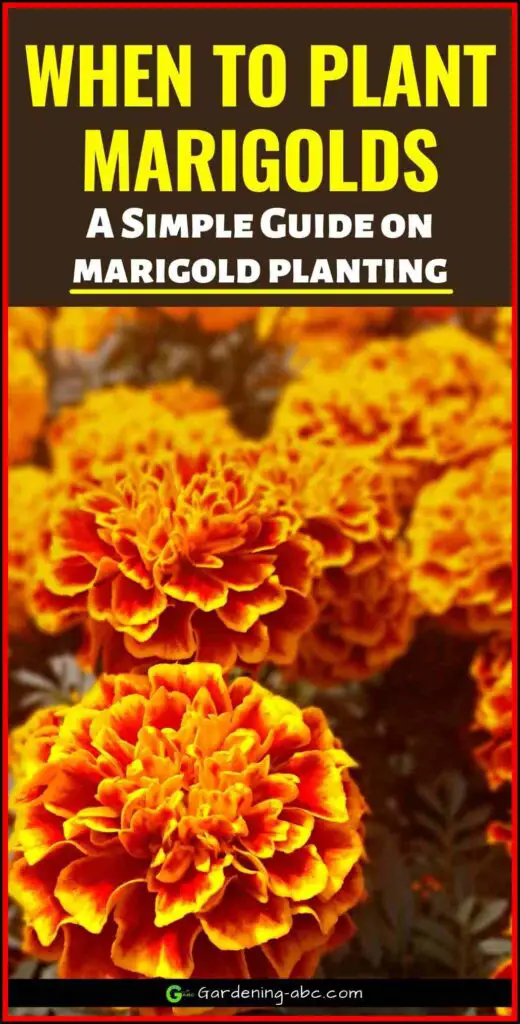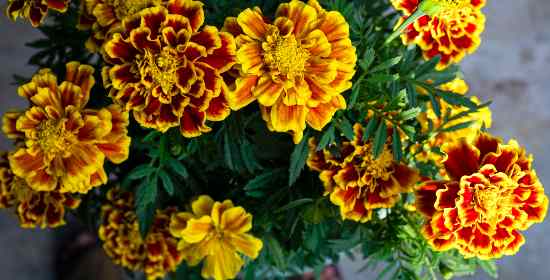We use affiliate links to run our site. When you buy through links on our site, we may earn an affiliate commission, without any added cost to you. Learn more
Planting marigolds is the perfect way to add a splash of color to your garden with minimal effort. But when it comes to actually planting and caring for the plants, it can all feel a bit overwhelming. Especially when you’re unsure of how and when to plant them.
Well, in this post, we will address both of these issues and everything you need to know about planting marigolds, so you can easily grow marigolds at home and have the best possible chance for success.
Which variety should I plant?
Marigolds are a wonderful plant for the garden, but there are many different types. Which one should you plant? The answer depends on what you need from your marigolds.
Two of the most popular type of marigolds are African marigolds and French Marigold. They come in a wide range of colors such as orange, yellow, and red, and also make an excellent border for your garden or container planting.
The French marigolds and signet marigolds grow up to 6-12 inches, making them ideal for smaller gardens where space is limited.
How to plant marigolds:
Marigolds are easy to grow from seed, but you can also purchase transplants at your local garden center. If you choose to plant seeds instead, buy them in late winter or early spring when they’re available.
Select a site:
Marigolds can be a tricky flower to grow. As they are annuals, they will die off naturally in the winter when there is an absence of sunlight.
The first step to planting marigold seeds is to choose the best location for them.
Marigolds love sunlight. Select a site with full sun, where the marigolds will receive at least six hours of direct sunlight per day. If you have partial shade, choose a spot that’s shaded for only part of each day.
Marigolds can tolerate some shade, but they won’t bloom as brightly or last as long if they don’t receive enough direct sunlight.
prepare the soil:
Marigolds need loose, well-drained soil that doesn’t contain excessive amounts of nitrogen or phosphorus. Prepare the soil by tilling it until it is loose and free of large clumps of dirt or weeds.
Add a little bit of compost to improve drainage and fertility.
Check the pH of the soil. marigolds prefer a soil pH of 6.0 to 7.0. if the soil is too acidic or alkaline use these methods to bring it to the optimum level.
Related Read:
when to plant marigolds:
If you are growing Young French and signet marigolds, then you can plant the seeds anytime from spring through midsummer.
For African marigolds, the best time to plant the seeds is in spring right after the dangers of the frost are over. They are slow growers so need a bit of time to mature and bloom.
How to thin seedlings
If you are planting marigold seeds directly in the ground, once they sprout you have thin them out. It is very important because it reduces competition and helps the plants to have plenty of space to grow. Thinning also improves air circulation around the plants.
To thin, cut off any extra plants at their base using clean pruning shears or sharp scissors.
Remove any weak or sickly-looking seedlings from the group so they don’t spread disease to other plants later on in life after they have become established in the ground.
Plant the strongest seedlings at regular intervals around the bed so there is plenty of space for each plant to grow without crowding others out.
spacing:
How much space you need to give between two plants depends on the variety of the marigold.
- Sow seeds 18 to 24 inches apart in the plant variety is larger.
- Give a gap of 12 to 15 inches between to marigold seeds if the plant variety in medium.
- For dwarf plants: space them 6 inches apart.
Taking care:
Marigolds don’t need much care when they are growing in your garden, but you can improve the health and appearance of the plant by giving it some attention.
If you choose not to do anything at all, your marigold will still come back next year and you can continue using it as a border plant or flowerbed filler until it eventually dies off.
However, if you would like your marigolds to look their best every year, then you should follow these tips for taking care of them once they have bloomed:
Stop Over Watering:
Marigolds like it hot and dry, so don’t overwater them. Check the soil moisture with your finger or a probe. If it’s dry to a depth of about 1 inch (2.5 centimeters), water lightly.
Water again when the soil dries out again. When in doubt, wait a day or two to see if the plants need water. If they need water, go ahead and give them some; if not, leave them alone.
Watering overhead can damage tender leaves and flowers, leading to disease problems or poor growth. Instead, water at the base of the plant so that water soaks into the ground away from the plant crowns and foliage.
You can read more about how to water a plant in this post
Deadhead as needed:
Marigolds are considered annuals and will die at the end of the growing season if left unpicked. Picking off dead flowers will keep your plant looking healthy and prevent it from going to seed.
Deadheading also encourages new growth, so don’t be afraid to cut back those browning leaves if they’re not interfering with other plants in the bed.
Stop fertilizing during the growing season:
Do not fertilize during the growing season. Fertilizers may stimulate excessive growth, which is more susceptible to pest damage and diseases than healthy, slow-growing plants.
Any excess nitrogen will only result in vegetative growth and no bloom.
If you want to give your marigold an early boost before spring planting, add compost tea or fish emulsion with each watering until it begins growing again on its own.
Add mulch:
Add mulch around your marigold plants as soon as possible after planting. Mulch adds twin benefits, it suppresses weeds from growing and keeps the soil nice, warm, and preserves soil moisture.
Give support:
Taller varieties, like African marigolds, need support so that they don’t fall over, especially during storms.
planting marigolds in containers:
Marigolds can be planted in pots and planters or directly in the ground, depending on your preference and the amount of time you want them around your home.
Planting marigolds in containers is a great way to add color and fragrance to your yard, especially if you have limited space.
Use a large enough container because marigolds tend to grow quickly, and crowding can be an issue.
You can use a soil-based potting mix to grow the plant. You can either add slow-releasing fertilizers at the time of planting or liquid fertilizer from time to time.
Place the pot in a sunny location and water it regularly until the seedling reaches maturity.
conclusion
Marigolds are a great plant to have in your garden. Not only do they bring color and texture, but they also repel different insects if you choose to grow marigolds near your other plants. Most importantly, marigolds can reduce nematodes in your garden — which are a real threat to many different crops.
I hope this post was helpful to you. You can read more posts related to growing marigolds here.
If you like the information, share it with others, and Don’t Forget to PIN IT.

Amazon and the Amazon logo are trademarks of Amazon.com, Inc, or its affiliates.

Hi there! My name is Prasenjit and I’m an avid gardener and someone who has grown a passion for growing plants. From my hands-on experience, I have learned what works and what doesn’t. Here I share everything I have learned.
